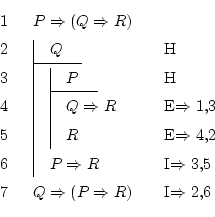Next: 5.7 One with proof Up: 5 Explained exercises Previous: 5.5 Reduction to the Contents
Things get harder. Here's the solution to
![]() :
:

But first: here we will only use the two rules that help adding and removing implications, since it's the only operator appearing in the formulas.
We want
![]() , so we will have to do a hypothesis
, so we will have to do a hypothesis
![]() inside of which we should prove that
inside of which we should prove that
![]() . We now
do that to simplify the problem: we open a subdemonstration at line
2. We won't close it until we discover that
. We now
do that to simplify the problem: we open a subdemonstration at line
2. We won't close it until we discover that
![]() is true.
is true.
Now the problem is somehow easier. We just need to prove
![]() ,
and we have two lines with two truths: the first says that
,
and we have two lines with two truths: the first says that
![]() ,
and the second says that
,
and the second says that ![]() .
.
How can we achieve the
![]() ? Well, as always: we must
suppose
? Well, as always: we must
suppose ![]() , and achieve that
, and achieve that ![]() is true, in some way. Even if
it doesn't seem very simple, it's what must be done, since implication
introduction works that way. So we're going to open another hypothesis,
now supposing
is true, in some way. Even if
it doesn't seem very simple, it's what must be done, since implication
introduction works that way. So we're going to open another hypothesis,
now supposing ![]() , and let's see if we achieve
, and let's see if we achieve ![]() . This will be
a hypothesis inside a hypothesis, but there's no problem in doing
that.
. This will be
a hypothesis inside a hypothesis, but there's no problem in doing
that.
After writing line 3, and being inside a subsubdemonstration,
we have available that
![]() , that
, that ![]() ,
and that
,
and that ![]() . We must prove
. We must prove ![]() . Now it isn't that hard, is it?
If we know that
. Now it isn't that hard, is it?
If we know that ![]() , we can use implication elimination on
line 1, and we will get the true formula
, we can use implication elimination on
line 1, and we will get the true formula
![]() . Since
. Since
![]() is also true (line 2), we can apply that rule again to discover
that
is also true (line 2), we can apply that rule again to discover
that ![]() .
.
We then see that supposing ![]() leads us to the conclusion
leads us to the conclusion ![]() , so
we can write down
, so
we can write down
![]() , which is what we wanted. Now
we've gone outside the subsubdemonstration, and we're only under the
supposition that
, which is what we wanted. Now
we've gone outside the subsubdemonstration, and we're only under the
supposition that ![]() is true. As we now see that this supposition
implies the truth of the formula
is true. As we now see that this supposition
implies the truth of the formula
![]() , we can end this
subdemonstration concluding that
, we can end this
subdemonstration concluding that
![]() .
.
![]() is precisely what had to be proven,
so we're finished.
is precisely what had to be proven,
so we're finished.
Daniel Clemente Laboreo 2005-05-17